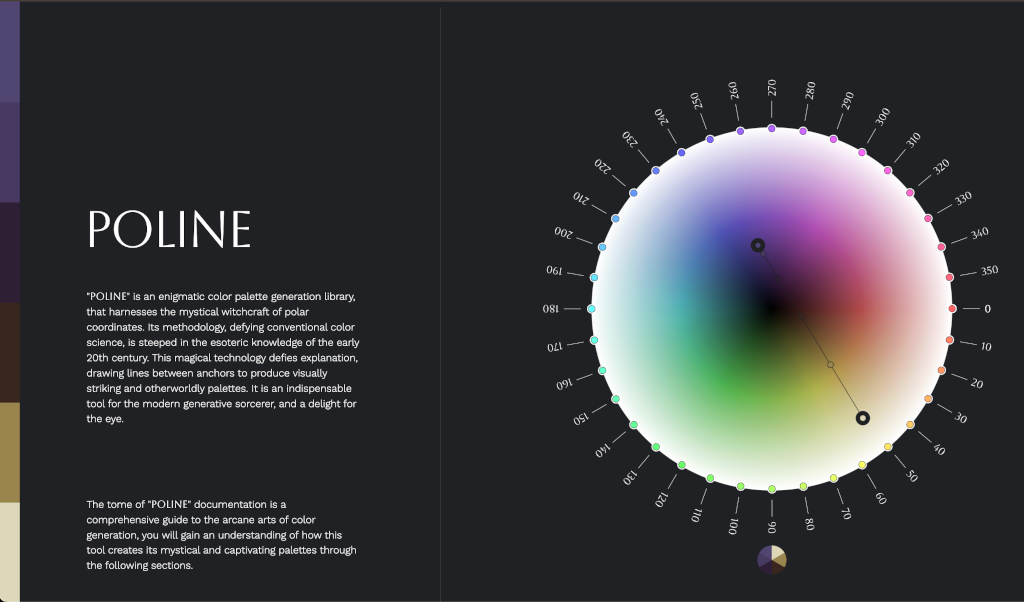- Published on
Poline: The Open-Source Colour Tool That Speaks the Language of Music
- Authors

- Name
- Joshua Jones
Poline: The Open-Source Colour Tool That Speaks the Language of Music

Every so often, a creative tool from outside the world of music captures the attention of producers, sound designers, and synth enthusiasts alike. Recently, a wave of musicians on Instagram and creative tech forums have been sharing something that isn't a plugin, pedal, or synth, but feels like one. It's called Poline, an open-source colour palette generator created by David Aerne, and it might be one of the most musically intuitive visual tools you'll ever encounter.
At first glance, Poline is a digital tool that builds smooth, evolving colour gradients. But spend five minutes playing with it and you'll realise something deeper is happening. Poline behaves like a synth for colour, you define a few base "notes," shape their relationships, and let the algorithm fill in the harmonies. The result isn't just aesthetic; it's expressive, emotional, and surprisingly similar to how we think about tone and timbre in sound.
Painting in Frequency Space
The magic of Poline comes from how it moves between anchor points — its "root notes." You start by choosing a handful of colours, then tweak how they interact: how far they spread, what kind of motion connects them (linear, curved, looping), and how quickly they transition. Instead of simply blending, Poline calculates transitions using polar coordinates in colour space, bending the path between hues the same way a filter sweep or pitch bend might glide between frequencies.
That's what makes it feel musical. You can "tune" a palette so it feels consonant and warm, or let it drift into dissonant, unpredictable territory. In a sense, it's colour theory that behaves like sound design.
This parallel to synthesis is striking. Aerne even describes Poline as a "system for designing relationships, not individual decisions." That's exactly what producers do when sculpting a mix: they shape relationships between sounds, balancing energy, tone, and emotion.
Why Musicians Are Falling for It
Poline has quietly become a favourite among creatives who blur the line between visual and sonic work, especially producers who use visual metaphors to organise their mixes or develop album art. Here's why it's striking such a chord:
Harmony and palette can work the same way A musical chord is a balance of frequencies that resonate together. A colour palette is the same idea applied to light. In both cases, tension and release matter. Just as a suspended fourth chord aches for resolution, a palette that drifts from cold blue into warm orange feels alive because of contrast. Poline gives you that balance automatically, you just set the parameters.
It invites improvisation Much like a modular synth, Poline rewards play. You can keep tweaking anchors, shifting hues, looping gradients, and watching what happens. There's no "right answer." You stumble into happy accidents, the same way you might when experimenting with delay feedback or granular reverb tails.
It translates emotion For many producers, visualising music helps to shape mood. Think of how DAWs like Ableton or Bitwig already assign colours to tracks: basslines in deep red, vocals in yellow, pads in blue. Poline takes that instinct and elevates it, creating colour systems that match the emotional contour of your music. You could even use its palettes to inspire album covers, lighting setups, or music video colour grading.
A Tool for Synesthetic Thinking
There's something quietly revolutionary about tools like Poline. They encourage what psychologists call cross-modal thinking; linking sound and vision, tone and hue, space and light. Even if you're not a synesthete, using colour as a compositional metaphor can make your production more intuitive.
Imagine if you will Designing an EP where each track is tied to a Poline-generated palette. Blues for ambient introspection, golds for euphoric drops. Using Poline to choose colours for your DAW tracks that match the emotional temperature of your arrangement. Building your stage visuals or lighting rig around the palette of your latest mix, creating a unified sensory world. It's a subtle but powerful mindset shift: treat colour as frequency, and the gap between visual art and music production starts to disappear.
The Open-Source Spirit
Another reason musicians love Poline? It's open source. You can dig into its code, remix it, or build your own version. That openness mirrors the ethos of music production communities online, where sharing patches, sample packs, and modular setups fuels creativity.
Aerne's approach reflects that spirit. Rather than hiding the process behind a paywall, he released it for anyone to explore, tweak, and learn from. That generosity is part of what makes Poline feel more like an instrument than a mere utility.
See Sound
Poline might not produce a single sound, but it speaks a language every musician understands: pattern, movement, harmony, and feeling. It's a reminder that creativity thrives when disciplines overlap, when producers think like painters, and developers think like composers.
Whether you use it to build album visuals, conceptualise sonic textures, or just clear your head between mix sessions, Poline offers something rare: a way to see sound.
And in a world where music and visual art increasingly blur together, from live visuals to DAW interfaces to the glow of synth LEDs, that's a palette worth exploring.
